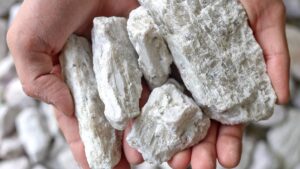Benchmark Gigafactories APAC: Lithium execs want funding certainty for ‘risky’ critical minerals

LTR, baby, what have you got for me? Pic: Getty Images
- Liontown chief commercial officer Grant Donald says new funding approach needed for critical minerals to support the energy transition
- Kathleen Valley mine owner lost support from some of its bankers after lithium dive led forecasters to slash forward prices
- Financiers say cost of accessing capital in the risk-off West is too high to compete with emerging mining markets
A leading executive at Australia’s newest lithium producer says critical minerals projects need a more supportive financing environment to fill growing demand from the energy transition.
Liontown Resources (ASX:LTR) was forced to recut a financing package and dump plans to fast-track the expansion its Kathleen Valley mine near Leinster in WA’s northern Goldfields earlier this year after falling spodumene price forecasts saw big banks get cold feet.
A sizeable portion of the eventual $550m package was ultimately replaced by a US$250m convertible note issued by South Korean offtake customer LG, in a sign banks were still unwilling to offer attractive commercial terms almost a decade after they began funding development in WA, the world’s largest lithium producing jurisdiction.
Those jitters came after benchmark 6% Li2O hard rock concentrate prices collapsed from over US$8000/t in late 2022 to ~US$800/t today.
“How many commodities are there that have a 10x differential between the lows and the highs of the market? And that’s exactly what we’ve seen in spodumene prices over the past year or two,” Liontown chief commercial officer Grant Donald said at the Benchmark Gigafactories APAC conference in Perth today.
“This means it’s hard for professional financiers to seep through the peaks and troughs and to finance long-term projects through the cycle. And this is where you may be surprised, to actually highlight our most important partners in financing are our customers.
“If you look across the industry, most development assets are held in single-asset, junior mining companies with limited financial resources. This means that not only is the commodity subject to significant price volatility, you also have relatively limited companies with balance sheets to support that volatility.
“This creates a significant need for financing to be able to support projects through development and ramp up.”

Keeping prices down
Liontown shares surged yesterday along with the rest of the ASX lithium sector after the closure of the Jianxiawo lepidolite mine in China. It kept rising this morning, up 5.8%.
Owned by the world’s biggest battery maker CATL, its output comes to around 2% of global supply, about a quarter of the market share of ASX giant Pilbara Minerals (ASX:PLS).
UBS, which broke the news yesterday, suggested price upside for lithium chemicals was around 11-23% this year against currently lowly levels in China of ~US$10,300/t tax included or US$8600/t without value added tax.
But that could be capped. At US$10,698/t, VAT excluded, CATL may be incentivised to restart production.
Yet supply is clearly coming out of the market at current prices, with Jianxiawo’s closure raising questions over the sustainability of non-integrated producers elsewhere in China’s lepidolite rich Jianxi Province.
Benchmark lithium product director Cam Perks said it may or may not be the ‘canary in the coal mine’, with production from that part of the world representing around 11% of global supply, potentially (but not definitely) bringing deficits to bear sooner.
Donald warned financiers needed to look beyond the boom-bust nature of the immature market to fill an investment requirement estimated by Benchmark of US$94bn in the lithium market needed by 2030 and double that by 2040.
“What’s clear is that we will need many more Kathleen Valleys for this transition to happen, and Liontown has demonstrated it is possible, but it isn’t easy, and it will require a much more supportive pricing and financing environment.”
Kathleen Valley, which is ramping up to a nameplate capacity of over 500,000tpa spodumene concentrate and counts as the world’s first underground hard rock lithium development, is planning to make its first shipment this month after a ~$1bn build.
Tim Goyder-founded LTR was forced to bring the mine to production itself after a raid by mega-billionaire Gina Rinehart scotched a $6.6bn takeover by US lithium giant Albemarle.
NOW READ: Benchmark Gigafactories APAC: UBS calls lithium bottom, sends share prices surging
Risk-off approach hurts the West
HSBC global head of metals, mining and transition materials Michael Willoughby told delegates at the conference the dominance of funds and institutions in western markets was limiting the capacity of companies to fund new developments through equity.
That placed more pressure on juniors to accrue debt to bankroll projects like lithium, graphite and nickel mines.
“85% of Western equity markets are institutional. Those institutions, they just want annuity style cash flows to match their liabilities, they don’t want big risk,” Willoughby said.
“They don’t care if it’s 10 times, 20 times, that’s not what they’re after. They’re after infrastructure, and that’s why infrastructure is priced at four times more expensive than mining assets, because it’s not volatile.”
In short, he said the cost of capital in the West is too high.
“Why is China, Indonesia, India, Saudi so successful at spending money on greenfield projects? Because their equity comes from often more than 50% retail shareholders who love that risk, but that’s how Australia was 40 years ago.
“It makes a huge difference. It means that the cost of equity capital for an emerging market company is 50% lower than it is for a Western company, which you then put that into the equation of what the returns are.
“All the government subsidies in the world can help, but they’re not going to solve that core problem.”
ANZ director of corporate finance Su D’Arcy said banks remained cautious with critical minerals projects because of cost overruns and the challenges of assessing returns for what are new markets and, at the technical level, novel processing techniques.
She said mitigating risks had been more challenging in critical minerals than in traditional sectors like gold.
“What we’ve seen with a lot of the critical minerals projects that have come up is actually these capex blowouts,” she said.
“You’ve got like 40% cost overruns and a lot of it’s been because of redesign.”
Related Topics

UNLOCK INSIGHTS
Discover the untold stories of emerging ASX stocks.
Daily news and expert analysis, it's free to subscribe.
By proceeding, you confirm you understand that we handle personal information in accordance with our Privacy Policy.








